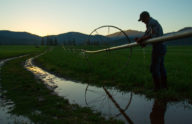The Nation’s WOTUS problem!
In response to the President’s Executive Order directing the EPA to revise the controversial rule redefining “waters of the United States” issued in 2015, EPA proposes to withdraw the rule, codify preexisting rules and guidance, and then issue a new WOTUS rule in keeping with Justice Scalia’s opinion in Rapanos v. United States. PLF has a vested interest in the outcome of this rule, not only because PLF is dedicated to safeguarding property rights and fighting government overreaching that threatens individual liberties, but also because PLF argued and won the Rapanos case in 2006. That case set long-overdue limits on the scope of the Clean Water Act that the government has since all but ignored. The current WOTUS rule that will be withdrawn is the most blatant power grab we have ever seen. It covers almost all waters (some puddles excluded) and vast land areas throughout the Country, without regard for the statutory text, Supreme Court precedent (like Rapanos), and constitutional constrains on federal authority. So, the Administration is to be lauded for its attempt to set things right.
However, we envision some pitfalls for the EPA in this endeavor. The first pitfall is the EPA’s proposed “temporary” reliance on preexisting rules and guidance documents. Taken together, these sources are nearly as bad as the current WOTUS rule. They are ambiguous, over broad, and inconsistent with Supreme Court precedent. For example, they still allow federal regulation of isolated intrastate, water bodies ruled off limits by the Supreme Court in SWANCC and all tributaries to traditional navigable waters that the court ruled could not be regulated in Rapanos. Obviously, the Administration envisions this as just an interim measure to provide “continuity” to the regulated public while the EPA drafts a new rule. However, it is possible that the “interim rule” could become the final rule be default if the new WOTUS rule is challenged (as it surely will) and is stayed by the courts where it spends years in litigation until a new Administration is ushered in that is antagonistic to the new rule and meaningful limits on federal power. What’s really needed in the short and long term is agency restraint, whatever rule the EPA adopts. The problem doesn’t lie only with the regulatory language, but with overzealous enforcement. Government officials should focus on protecting core water resources instead of pushing the envelope on federal power by prosecuting minor or imaginary infractions such as digging a drainage ditch, creating a stock pond, plowing farmland, or building a house in a built-out subdivision, like it does now.
Another pitfall is the EPA’s propensity for willfully misconstruing statutory text, Supreme Court case law, and even its own regulations. Although the EPA has been directed to revise the WOTUS rule along the lines of the Scalia opinion in Rapanos, the agency has already shown an inability or unwillingness to properly interpret that opinion. The 2008 Rapanos guidance is a case in point. That document purports to interpret the Scalia opinion but in actuality it distorts that opinion to give the agency broader powers than Justice Scalia intended.
Nevertheless, in the hope that the EPA is now willing to curtail agency excesses, I have drafted a proposed definition of “waters of the United States” for general consideration:
Amend 33 C.F.R. § 328.3 to read:
a. The term “waters of the United States” includes ONLY:
1. Those interstate waters that are navigable-in-fact and currently used or susceptible to use in interstate or foreign commerce. These waters include the territorial seas.
2. Permanent, standing or continuously flowing streams, rivers, and lakes directly connected to navigable-in-fact waters described in a.1. Continuously flowing means an uninterrupted flow except in extreme weather conditions such as drought. These waters do not include groundwater or channels through which waters flow intermittently or ephemerally, or channels that provide only periodic drainage, such as from rainfall.
3. Those wetlands that directly abut and are indistinguishable from the waters described in a.1. and a.2. Wetlands are those areas inundated or saturated by surface or groundwater at a frequency and duration sufficient to support, and that under normal circumstances do support, a prevalence of vegetation typically adapted for life in saturated soil conditions. Wetlands generally include swamps, marshes, and bogs. Wetlands are indistinguishable from the waters described in a.1. and a.2. when the wetlands and waters have merged so there is no clear demarcation between the two.
This definition would reduce federal regulation of local waters that the States can and should regulate while providing a measure of certainty to the regulators and regulated public consistent with the Scalia opinion, the text of the Clean Water Act, the President’s Executive Order, and constitutional limitations.
This proposal can be viewed here as a separate document.



